Critical Evaluation of Climate Change Data in a Detailed Case Study
VerifiedAdded on 2023/06/16
|8
|2611
|407
Report
AI Summary
This report provides a critical analysis of climate change, focusing on the application of logical reasoning to evaluate arguments presented in a case study. It delves into inductive, deductive, abductive, and adductive reasoning to understand the impact of climate change and the challenges in addressing it. The report also critically evaluates the sources of information and data used in the case study, employing the CRAP test to validate their credibility and relevance. The analysis includes a detailed examination of public views on climate change, particularly the differing opinions among various demographic and political groups. Ultimately, the report concludes that climate change is a present crisis requiring immediate action, supported by robust evidence and reliable data, emphasizing the importance of critical thinking in understanding and addressing this global challenge. Desklib offers this and many more solved assignments for students.
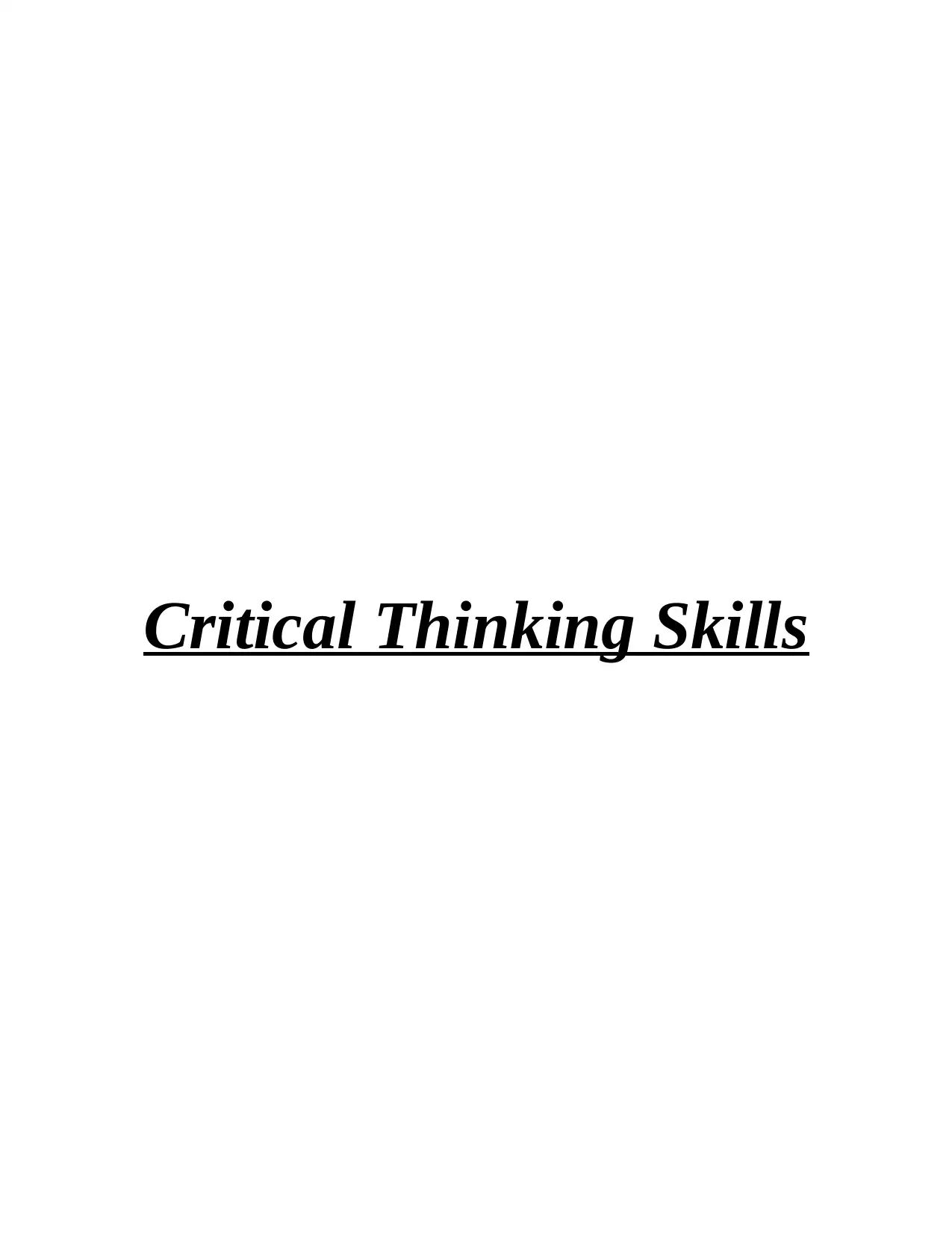
Critical Thinking Skills
Paraphrase This Document
Need a fresh take? Get an instant paraphrase of this document with our AI Paraphraser
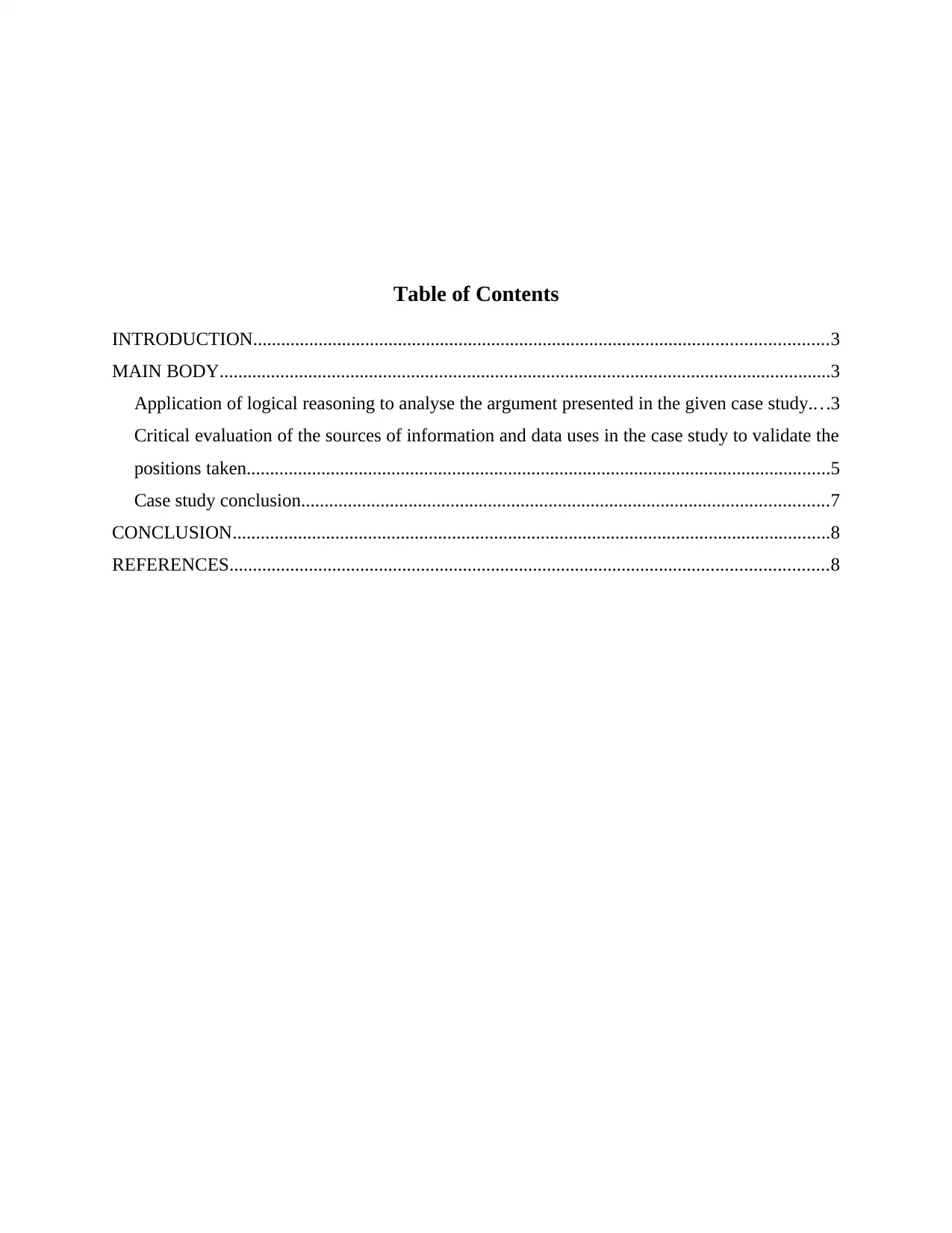
Table of Contents
INTRODUCTION...........................................................................................................................3
MAIN BODY...................................................................................................................................3
Application of logical reasoning to analyse the argument presented in the given case study....3
Critical evaluation of the sources of information and data uses in the case study to validate the
positions taken.............................................................................................................................5
Case study conclusion.................................................................................................................7
CONCLUSION................................................................................................................................8
REFERENCES................................................................................................................................8
INTRODUCTION...........................................................................................................................3
MAIN BODY...................................................................................................................................3
Application of logical reasoning to analyse the argument presented in the given case study....3
Critical evaluation of the sources of information and data uses in the case study to validate the
positions taken.............................................................................................................................5
Case study conclusion.................................................................................................................7
CONCLUSION................................................................................................................................8
REFERENCES................................................................................................................................8
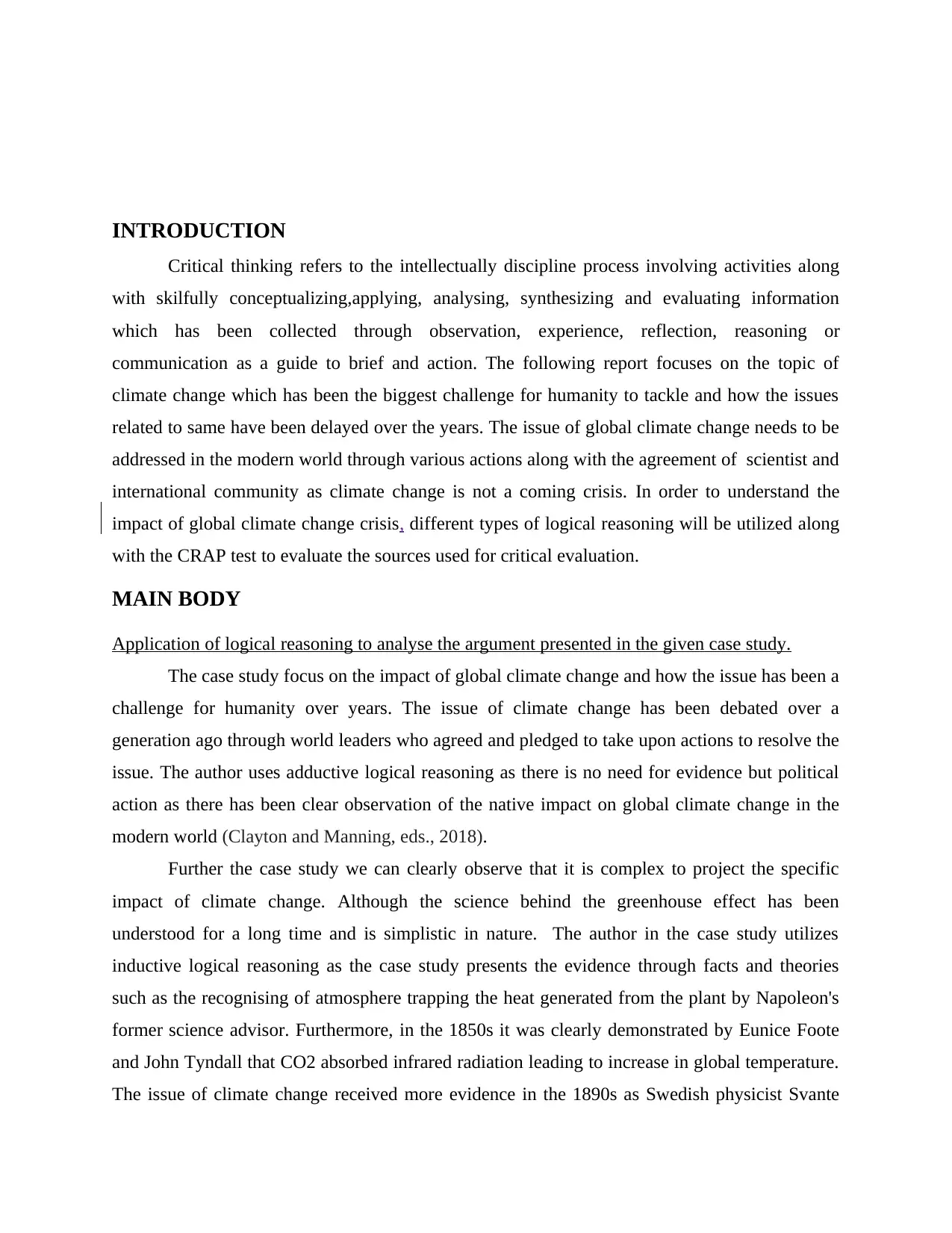
INTRODUCTION
Critical thinking refers to the intellectually discipline process involving activities along
with skilfully conceptualizing,applying, analysing, synthesizing and evaluating information
which has been collected through observation, experience, reflection, reasoning or
communication as a guide to brief and action. The following report focuses on the topic of
climate change which has been the biggest challenge for humanity to tackle and how the issues
related to same have been delayed over the years. The issue of global climate change needs to be
addressed in the modern world through various actions along with the agreement of scientist and
international community as climate change is not a coming crisis. In order to understand the
impact of global climate change crisis, different types of logical reasoning will be utilized along
with the CRAP test to evaluate the sources used for critical evaluation.
MAIN BODY
Application of logical reasoning to analyse the argument presented in the given case study.
The case study focus on the impact of global climate change and how the issue has been a
challenge for humanity over years. The issue of climate change has been debated over a
generation ago through world leaders who agreed and pledged to take upon actions to resolve the
issue. The author uses adductive logical reasoning as there is no need for evidence but political
action as there has been clear observation of the native impact on global climate change in the
modern world (Clayton and Manning, eds., 2018).
Further the case study we can clearly observe that it is complex to project the specific
impact of climate change. Although the science behind the greenhouse effect has been
understood for a long time and is simplistic in nature. The author in the case study utilizes
inductive logical reasoning as the case study presents the evidence through facts and theories
such as the recognising of atmosphere trapping the heat generated from the plant by Napoleon's
former science advisor. Furthermore, in the 1850s it was clearly demonstrated by Eunice Foote
and John Tyndall that CO2 absorbed infrared radiation leading to increase in global temperature.
The issue of climate change received more evidence in the 1890s as Swedish physicist Svante
Critical thinking refers to the intellectually discipline process involving activities along
with skilfully conceptualizing,applying, analysing, synthesizing and evaluating information
which has been collected through observation, experience, reflection, reasoning or
communication as a guide to brief and action. The following report focuses on the topic of
climate change which has been the biggest challenge for humanity to tackle and how the issues
related to same have been delayed over the years. The issue of global climate change needs to be
addressed in the modern world through various actions along with the agreement of scientist and
international community as climate change is not a coming crisis. In order to understand the
impact of global climate change crisis, different types of logical reasoning will be utilized along
with the CRAP test to evaluate the sources used for critical evaluation.
MAIN BODY
Application of logical reasoning to analyse the argument presented in the given case study.
The case study focus on the impact of global climate change and how the issue has been a
challenge for humanity over years. The issue of climate change has been debated over a
generation ago through world leaders who agreed and pledged to take upon actions to resolve the
issue. The author uses adductive logical reasoning as there is no need for evidence but political
action as there has been clear observation of the native impact on global climate change in the
modern world (Clayton and Manning, eds., 2018).
Further the case study we can clearly observe that it is complex to project the specific
impact of climate change. Although the science behind the greenhouse effect has been
understood for a long time and is simplistic in nature. The author in the case study utilizes
inductive logical reasoning as the case study presents the evidence through facts and theories
such as the recognising of atmosphere trapping the heat generated from the plant by Napoleon's
former science advisor. Furthermore, in the 1850s it was clearly demonstrated by Eunice Foote
and John Tyndall that CO2 absorbed infrared radiation leading to increase in global temperature.
The issue of climate change received more evidence in the 1890s as Swedish physicist Svante
⊘ This is a preview!⊘
Do you want full access?
Subscribe today to unlock all pages.

Trusted by 1+ million students worldwide
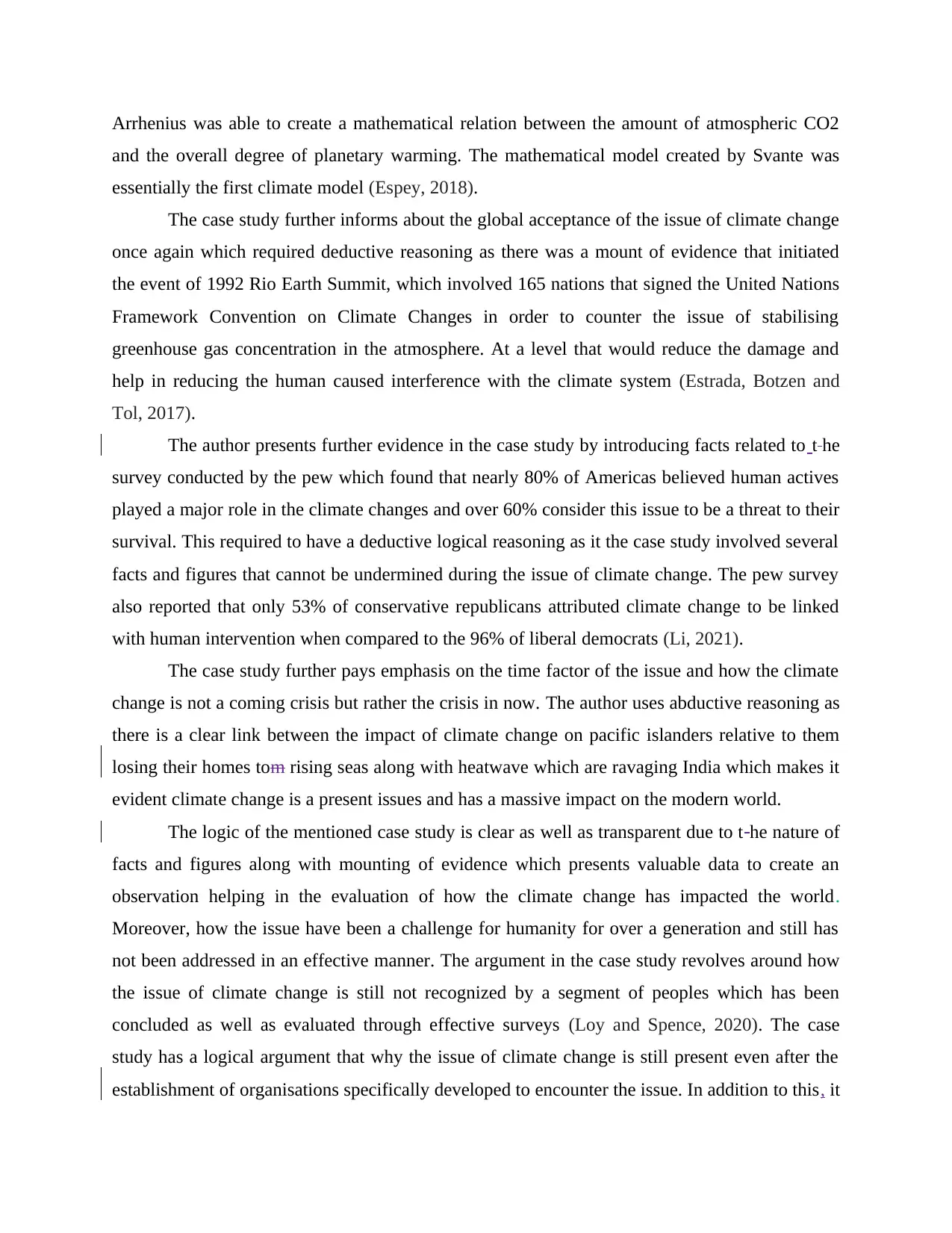
Arrhenius was able to create a mathematical relation between the amount of atmospheric CO2
and the overall degree of planetary warming. The mathematical model created by Svante was
essentially the first climate model (Espey, 2018).
The case study further informs about the global acceptance of the issue of climate change
once again which required deductive reasoning as there was a mount of evidence that initiated
the event of 1992 Rio Earth Summit, which involved 165 nations that signed the United Nations
Framework Convention on Climate Changes in order to counter the issue of stabilising
greenhouse gas concentration in the atmosphere. At a level that would reduce the damage and
help in reducing the human caused interference with the climate system (Estrada, Botzen and
Tol, 2017).
The author presents further evidence in the case study by introducing facts related to t he
survey conducted by the pew which found that nearly 80% of Americas believed human actives
played a major role in the climate changes and over 60% consider this issue to be a threat to their
survival. This required to have a deductive logical reasoning as it the case study involved several
facts and figures that cannot be undermined during the issue of climate change. The pew survey
also reported that only 53% of conservative republicans attributed climate change to be linked
with human intervention when compared to the 96% of liberal democrats (Li, 2021).
The case study further pays emphasis on the time factor of the issue and how the climate
change is not a coming crisis but rather the crisis in now. The author uses abductive reasoning as
there is a clear link between the impact of climate change on pacific islanders relative to them
losing their homes tom rising seas along with heatwave which are ravaging India which makes it
evident climate change is a present issues and has a massive impact on the modern world.
The logic of the mentioned case study is clear as well as transparent due to t he nature of
facts and figures along with mounting of evidence which presents valuable data to create an
observation helping in the evaluation of how the climate change has impacted the world.
Moreover, how the issue have been a challenge for humanity for over a generation and still has
not been addressed in an effective manner. The argument in the case study revolves around how
the issue of climate change is still not recognized by a segment of peoples which has been
concluded as well as evaluated through effective surveys (Loy and Spence, 2020). The case
study has a logical argument that why the issue of climate change is still present even after the
establishment of organisations specifically developed to encounter the issue. In addition to this, it
and the overall degree of planetary warming. The mathematical model created by Svante was
essentially the first climate model (Espey, 2018).
The case study further informs about the global acceptance of the issue of climate change
once again which required deductive reasoning as there was a mount of evidence that initiated
the event of 1992 Rio Earth Summit, which involved 165 nations that signed the United Nations
Framework Convention on Climate Changes in order to counter the issue of stabilising
greenhouse gas concentration in the atmosphere. At a level that would reduce the damage and
help in reducing the human caused interference with the climate system (Estrada, Botzen and
Tol, 2017).
The author presents further evidence in the case study by introducing facts related to t he
survey conducted by the pew which found that nearly 80% of Americas believed human actives
played a major role in the climate changes and over 60% consider this issue to be a threat to their
survival. This required to have a deductive logical reasoning as it the case study involved several
facts and figures that cannot be undermined during the issue of climate change. The pew survey
also reported that only 53% of conservative republicans attributed climate change to be linked
with human intervention when compared to the 96% of liberal democrats (Li, 2021).
The case study further pays emphasis on the time factor of the issue and how the climate
change is not a coming crisis but rather the crisis in now. The author uses abductive reasoning as
there is a clear link between the impact of climate change on pacific islanders relative to them
losing their homes tom rising seas along with heatwave which are ravaging India which makes it
evident climate change is a present issues and has a massive impact on the modern world.
The logic of the mentioned case study is clear as well as transparent due to t he nature of
facts and figures along with mounting of evidence which presents valuable data to create an
observation helping in the evaluation of how the climate change has impacted the world.
Moreover, how the issue have been a challenge for humanity for over a generation and still has
not been addressed in an effective manner. The argument in the case study revolves around how
the issue of climate change is still not recognized by a segment of peoples which has been
concluded as well as evaluated through effective surveys (Loy and Spence, 2020). The case
study has a logical argument that why the issue of climate change is still present even after the
establishment of organisations specifically developed to encounter the issue. In addition to this, it
Paraphrase This Document
Need a fresh take? Get an instant paraphrase of this document with our AI Paraphraser
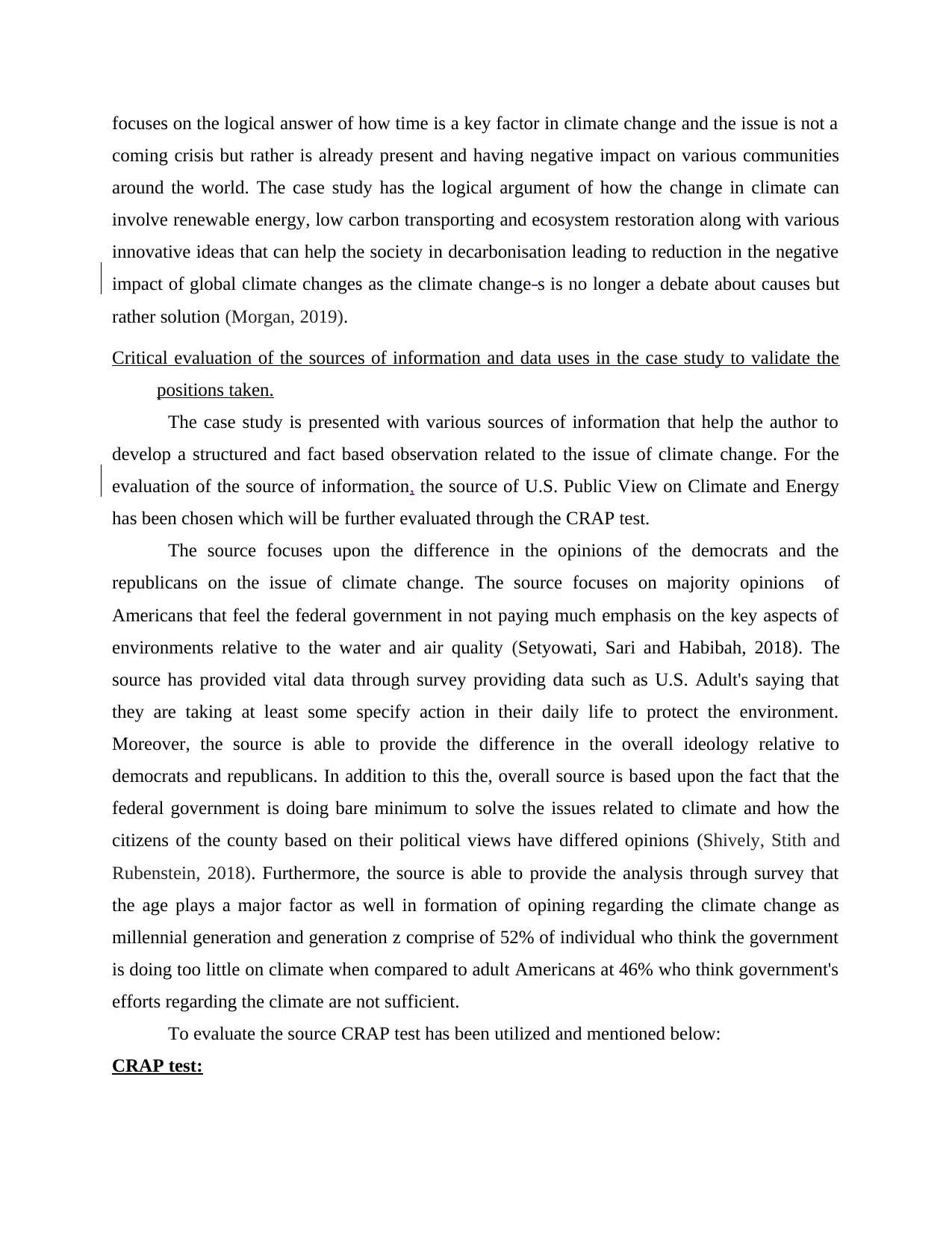
focuses on the logical answer of how time is a key factor in climate change and the issue is not a
coming crisis but rather is already present and having negative impact on various communities
around the world. The case study has the logical argument of how the change in climate can
involve renewable energy, low carbon transporting and ecosystem restoration along with various
innovative ideas that can help the society in decarbonisation leading to reduction in the negative
impact of global climate changes as the climate change s is no longer a debate about causes but
rather solution (Morgan, 2019).
Critical evaluation of the sources of information and data uses in the case study to validate the
positions taken.
The case study is presented with various sources of information that help the author to
develop a structured and fact based observation related to the issue of climate change. For the
evaluation of the source of information, the source of U.S. Public View on Climate and Energy
has been chosen which will be further evaluated through the CRAP test.
The source focuses upon the difference in the opinions of the democrats and the
republicans on the issue of climate change. The source focuses on majority opinions of
Americans that feel the federal government in not paying much emphasis on the key aspects of
environments relative to the water and air quality (Setyowati, Sari and Habibah, 2018). The
source has provided vital data through survey providing data such as U.S. Adult's saying that
they are taking at least some specify action in their daily life to protect the environment.
Moreover, the source is able to provide the difference in the overall ideology relative to
democrats and republicans. In addition to this the, overall source is based upon the fact that the
federal government is doing bare minimum to solve the issues related to climate and how the
citizens of the county based on their political views have differed opinions (Shively, Stith and
Rubenstein, 2018). Furthermore, the source is able to provide the analysis through survey that
the age plays a major factor as well in formation of opining regarding the climate change as
millennial generation and generation z comprise of 52% of individual who think the government
is doing too little on climate when compared to adult Americans at 46% who think government's
efforts regarding the climate are not sufficient.
To evaluate the source CRAP test has been utilized and mentioned below:
CRAP test:
coming crisis but rather is already present and having negative impact on various communities
around the world. The case study has the logical argument of how the change in climate can
involve renewable energy, low carbon transporting and ecosystem restoration along with various
innovative ideas that can help the society in decarbonisation leading to reduction in the negative
impact of global climate changes as the climate change s is no longer a debate about causes but
rather solution (Morgan, 2019).
Critical evaluation of the sources of information and data uses in the case study to validate the
positions taken.
The case study is presented with various sources of information that help the author to
develop a structured and fact based observation related to the issue of climate change. For the
evaluation of the source of information, the source of U.S. Public View on Climate and Energy
has been chosen which will be further evaluated through the CRAP test.
The source focuses upon the difference in the opinions of the democrats and the
republicans on the issue of climate change. The source focuses on majority opinions of
Americans that feel the federal government in not paying much emphasis on the key aspects of
environments relative to the water and air quality (Setyowati, Sari and Habibah, 2018). The
source has provided vital data through survey providing data such as U.S. Adult's saying that
they are taking at least some specify action in their daily life to protect the environment.
Moreover, the source is able to provide the difference in the overall ideology relative to
democrats and republicans. In addition to this the, overall source is based upon the fact that the
federal government is doing bare minimum to solve the issues related to climate and how the
citizens of the county based on their political views have differed opinions (Shively, Stith and
Rubenstein, 2018). Furthermore, the source is able to provide the analysis through survey that
the age plays a major factor as well in formation of opining regarding the climate change as
millennial generation and generation z comprise of 52% of individual who think the government
is doing too little on climate when compared to adult Americans at 46% who think government's
efforts regarding the climate are not sufficient.
To evaluate the source CRAP test has been utilized and mentioned below:
CRAP test:
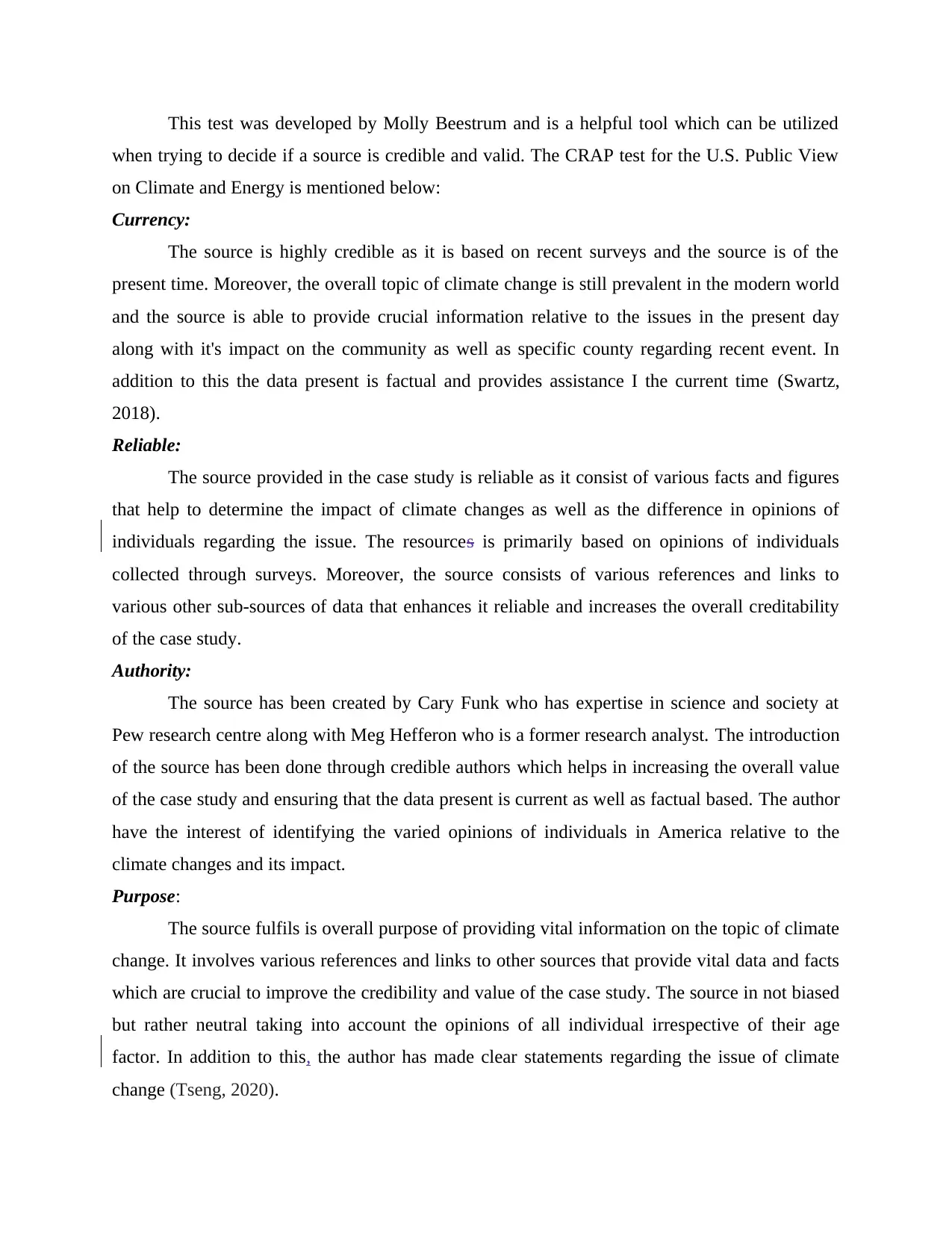
This test was developed by Molly Beestrum and is a helpful tool which can be utilized
when trying to decide if a source is credible and valid. The CRAP test for the U.S. Public View
on Climate and Energy is mentioned below:
Currency:
The source is highly credible as it is based on recent surveys and the source is of the
present time. Moreover, the overall topic of climate change is still prevalent in the modern world
and the source is able to provide crucial information relative to the issues in the present day
along with it's impact on the community as well as specific county regarding recent event. In
addition to this the data present is factual and provides assistance I the current time (Swartz,
2018).
Reliable:
The source provided in the case study is reliable as it consist of various facts and figures
that help to determine the impact of climate changes as well as the difference in opinions of
individuals regarding the issue. The resources is primarily based on opinions of individuals
collected through surveys. Moreover, the source consists of various references and links to
various other sub-sources of data that enhances it reliable and increases the overall creditability
of the case study.
Authority:
The source has been created by Cary Funk who has expertise in science and society at
Pew research centre along with Meg Hefferon who is a former research analyst. The introduction
of the source has been done through credible authors which helps in increasing the overall value
of the case study and ensuring that the data present is current as well as factual based. The author
have the interest of identifying the varied opinions of individuals in America relative to the
climate changes and its impact.
Purpose:
The source fulfils is overall purpose of providing vital information on the topic of climate
change. It involves various references and links to other sources that provide vital data and facts
which are crucial to improve the credibility and value of the case study. The source in not biased
but rather neutral taking into account the opinions of all individual irrespective of their age
factor. In addition to this, the author has made clear statements regarding the issue of climate
change (Tseng, 2020).
when trying to decide if a source is credible and valid. The CRAP test for the U.S. Public View
on Climate and Energy is mentioned below:
Currency:
The source is highly credible as it is based on recent surveys and the source is of the
present time. Moreover, the overall topic of climate change is still prevalent in the modern world
and the source is able to provide crucial information relative to the issues in the present day
along with it's impact on the community as well as specific county regarding recent event. In
addition to this the data present is factual and provides assistance I the current time (Swartz,
2018).
Reliable:
The source provided in the case study is reliable as it consist of various facts and figures
that help to determine the impact of climate changes as well as the difference in opinions of
individuals regarding the issue. The resources is primarily based on opinions of individuals
collected through surveys. Moreover, the source consists of various references and links to
various other sub-sources of data that enhances it reliable and increases the overall creditability
of the case study.
Authority:
The source has been created by Cary Funk who has expertise in science and society at
Pew research centre along with Meg Hefferon who is a former research analyst. The introduction
of the source has been done through credible authors which helps in increasing the overall value
of the case study and ensuring that the data present is current as well as factual based. The author
have the interest of identifying the varied opinions of individuals in America relative to the
climate changes and its impact.
Purpose:
The source fulfils is overall purpose of providing vital information on the topic of climate
change. It involves various references and links to other sources that provide vital data and facts
which are crucial to improve the credibility and value of the case study. The source in not biased
but rather neutral taking into account the opinions of all individual irrespective of their age
factor. In addition to this, the author has made clear statements regarding the issue of climate
change (Tseng, 2020).
⊘ This is a preview!⊘
Do you want full access?
Subscribe today to unlock all pages.

Trusted by 1+ million students worldwide
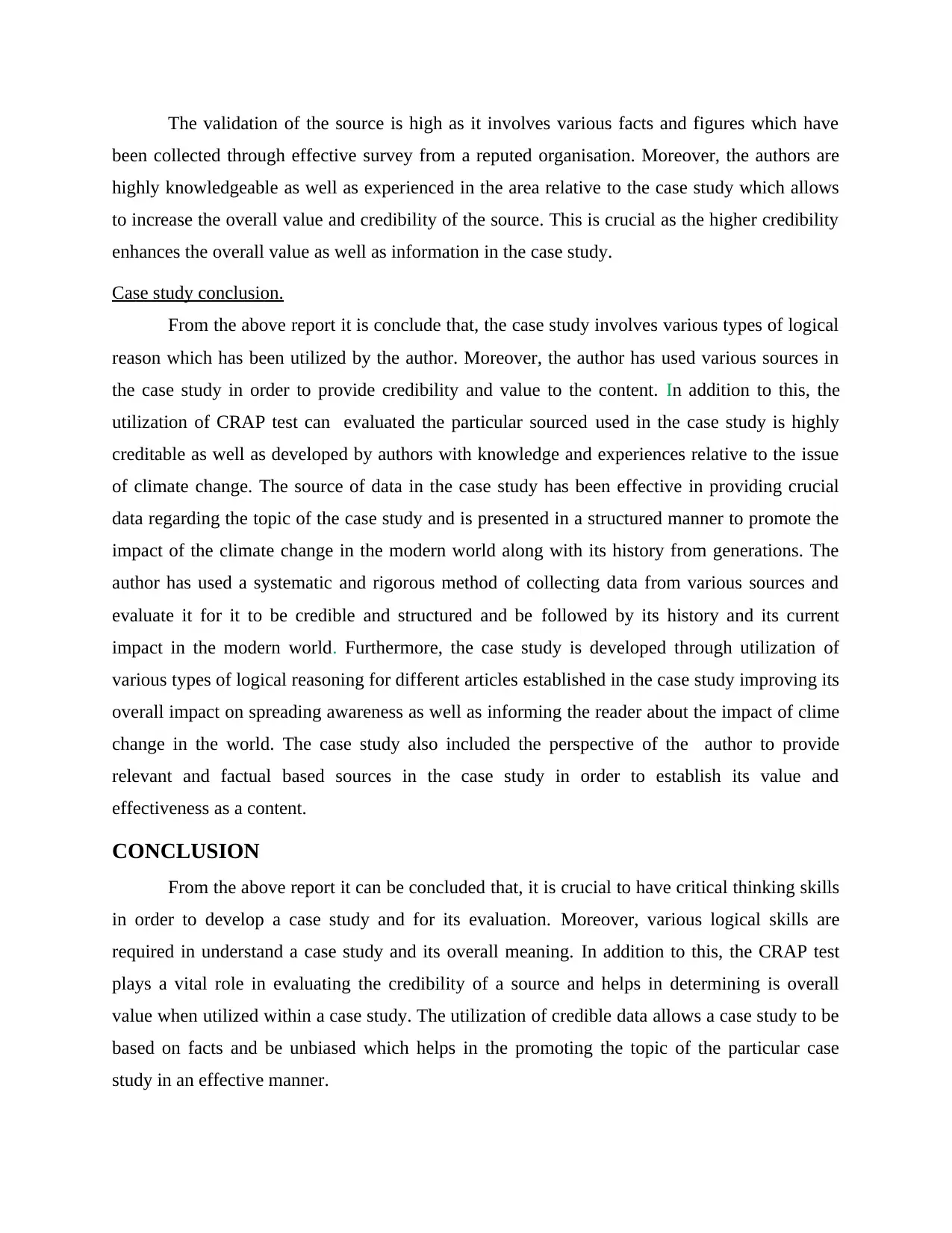
The validation of the source is high as it involves various facts and figures which have
been collected through effective survey from a reputed organisation. Moreover, the authors are
highly knowledgeable as well as experienced in the area relative to the case study which allows
to increase the overall value and credibility of the source. This is crucial as the higher credibility
enhances the overall value as well as information in the case study.
Case study conclusion.
From the above report it is conclude that, the case study involves various types of logical
reason which has been utilized by the author. Moreover, the author has used various sources in
the case study in order to provide credibility and value to the content. In addition to this, the
utilization of CRAP test can evaluated the particular sourced used in the case study is highly
creditable as well as developed by authors with knowledge and experiences relative to the issue
of climate change. The source of data in the case study has been effective in providing crucial
data regarding the topic of the case study and is presented in a structured manner to promote the
impact of the climate change in the modern world along with its history from generations. The
author has used a systematic and rigorous method of collecting data from various sources and
evaluate it for it to be credible and structured and be followed by its history and its current
impact in the modern world. Furthermore, the case study is developed through utilization of
various types of logical reasoning for different articles established in the case study improving its
overall impact on spreading awareness as well as informing the reader about the impact of clime
change in the world. The case study also included the perspective of the author to provide
relevant and factual based sources in the case study in order to establish its value and
effectiveness as a content.
CONCLUSION
From the above report it can be concluded that, it is crucial to have critical thinking skills
in order to develop a case study and for its evaluation. Moreover, various logical skills are
required in understand a case study and its overall meaning. In addition to this, the CRAP test
plays a vital role in evaluating the credibility of a source and helps in determining is overall
value when utilized within a case study. The utilization of credible data allows a case study to be
based on facts and be unbiased which helps in the promoting the topic of the particular case
study in an effective manner.
been collected through effective survey from a reputed organisation. Moreover, the authors are
highly knowledgeable as well as experienced in the area relative to the case study which allows
to increase the overall value and credibility of the source. This is crucial as the higher credibility
enhances the overall value as well as information in the case study.
Case study conclusion.
From the above report it is conclude that, the case study involves various types of logical
reason which has been utilized by the author. Moreover, the author has used various sources in
the case study in order to provide credibility and value to the content. In addition to this, the
utilization of CRAP test can evaluated the particular sourced used in the case study is highly
creditable as well as developed by authors with knowledge and experiences relative to the issue
of climate change. The source of data in the case study has been effective in providing crucial
data regarding the topic of the case study and is presented in a structured manner to promote the
impact of the climate change in the modern world along with its history from generations. The
author has used a systematic and rigorous method of collecting data from various sources and
evaluate it for it to be credible and structured and be followed by its history and its current
impact in the modern world. Furthermore, the case study is developed through utilization of
various types of logical reasoning for different articles established in the case study improving its
overall impact on spreading awareness as well as informing the reader about the impact of clime
change in the world. The case study also included the perspective of the author to provide
relevant and factual based sources in the case study in order to establish its value and
effectiveness as a content.
CONCLUSION
From the above report it can be concluded that, it is crucial to have critical thinking skills
in order to develop a case study and for its evaluation. Moreover, various logical skills are
required in understand a case study and its overall meaning. In addition to this, the CRAP test
plays a vital role in evaluating the credibility of a source and helps in determining is overall
value when utilized within a case study. The utilization of credible data allows a case study to be
based on facts and be unbiased which helps in the promoting the topic of the particular case
study in an effective manner.
Paraphrase This Document
Need a fresh take? Get an instant paraphrase of this document with our AI Paraphraser
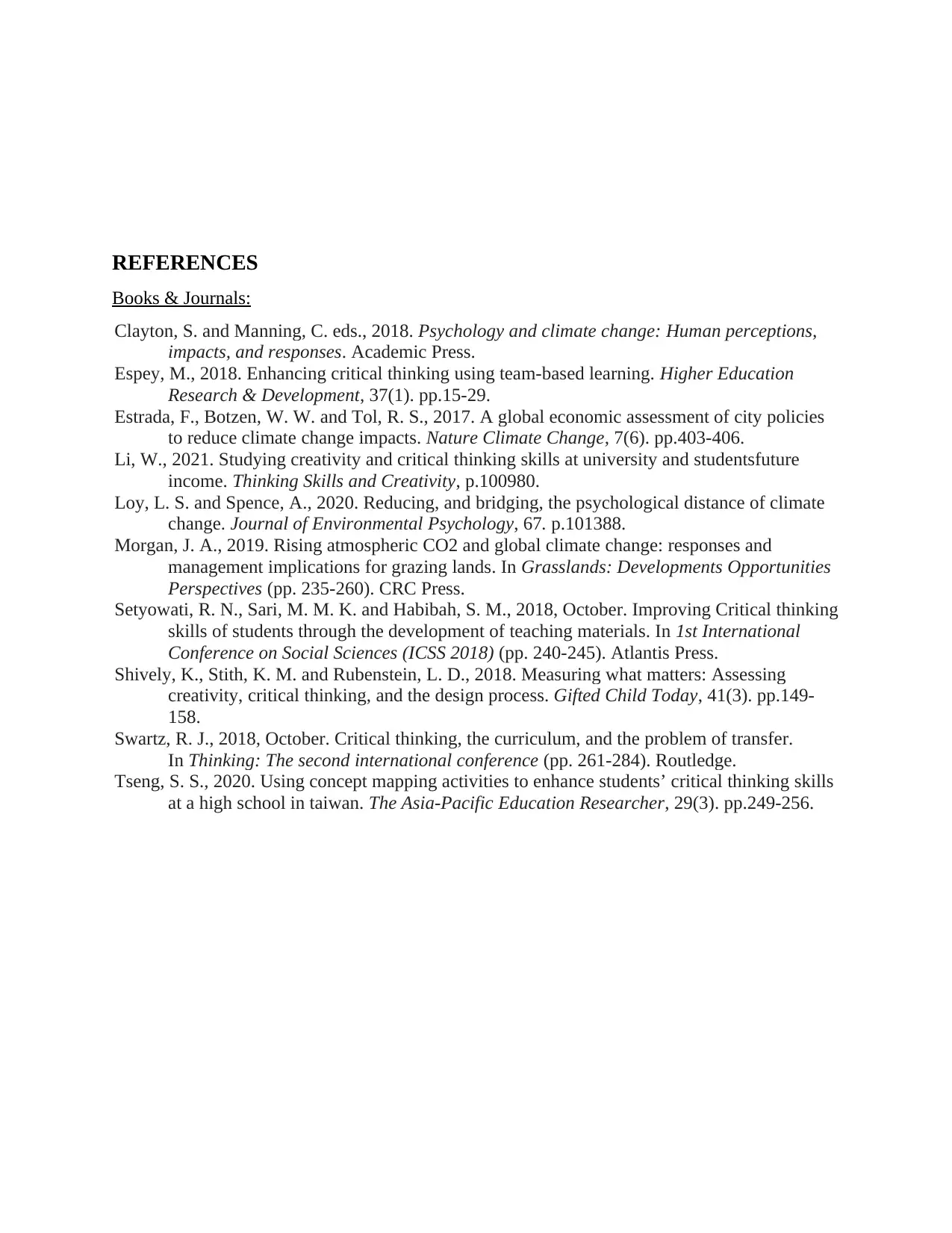
REFERENCES
Books & Journals:
Clayton, S. and Manning, C. eds., 2018. Psychology and climate change: Human perceptions,
impacts, and responses. Academic Press.
Espey, M., 2018. Enhancing critical thinking using team-based learning. Higher Education
Research & Development, 37(1). pp.15-29.
Estrada, F., Botzen, W. W. and Tol, R. S., 2017. A global economic assessment of city policies
to reduce climate change impacts. Nature Climate Change, 7(6). pp.403-406.
Li, W., 2021. Studying creativity and critical thinking skills at university and studentsfuture
income. Thinking Skills and Creativity, p.100980.
Loy, L. S. and Spence, A., 2020. Reducing, and bridging, the psychological distance of climate
change. Journal of Environmental Psychology, 67. p.101388.
Morgan, J. A., 2019. Rising atmospheric CO2 and global climate change: responses and
management implications for grazing lands. In Grasslands: Developments Opportunities
Perspectives (pp. 235-260). CRC Press.
Setyowati, R. N., Sari, M. M. K. and Habibah, S. M., 2018, October. Improving Critical thinking
skills of students through the development of teaching materials. In 1st International
Conference on Social Sciences (ICSS 2018) (pp. 240-245). Atlantis Press.
Shively, K., Stith, K. M. and Rubenstein, L. D., 2018. Measuring what matters: Assessing
creativity, critical thinking, and the design process. Gifted Child Today, 41(3). pp.149-
158.
Swartz, R. J., 2018, October. Critical thinking, the curriculum, and the problem of transfer.
In Thinking: The second international conference (pp. 261-284). Routledge.
Tseng, S. S., 2020. Using concept mapping activities to enhance students’ critical thinking skills
at a high school in taiwan. The Asia-Pacific Education Researcher, 29(3). pp.249-256.
Books & Journals:
Clayton, S. and Manning, C. eds., 2018. Psychology and climate change: Human perceptions,
impacts, and responses. Academic Press.
Espey, M., 2018. Enhancing critical thinking using team-based learning. Higher Education
Research & Development, 37(1). pp.15-29.
Estrada, F., Botzen, W. W. and Tol, R. S., 2017. A global economic assessment of city policies
to reduce climate change impacts. Nature Climate Change, 7(6). pp.403-406.
Li, W., 2021. Studying creativity and critical thinking skills at university and studentsfuture
income. Thinking Skills and Creativity, p.100980.
Loy, L. S. and Spence, A., 2020. Reducing, and bridging, the psychological distance of climate
change. Journal of Environmental Psychology, 67. p.101388.
Morgan, J. A., 2019. Rising atmospheric CO2 and global climate change: responses and
management implications for grazing lands. In Grasslands: Developments Opportunities
Perspectives (pp. 235-260). CRC Press.
Setyowati, R. N., Sari, M. M. K. and Habibah, S. M., 2018, October. Improving Critical thinking
skills of students through the development of teaching materials. In 1st International
Conference on Social Sciences (ICSS 2018) (pp. 240-245). Atlantis Press.
Shively, K., Stith, K. M. and Rubenstein, L. D., 2018. Measuring what matters: Assessing
creativity, critical thinking, and the design process. Gifted Child Today, 41(3). pp.149-
158.
Swartz, R. J., 2018, October. Critical thinking, the curriculum, and the problem of transfer.
In Thinking: The second international conference (pp. 261-284). Routledge.
Tseng, S. S., 2020. Using concept mapping activities to enhance students’ critical thinking skills
at a high school in taiwan. The Asia-Pacific Education Researcher, 29(3). pp.249-256.
1 out of 8
Related Documents
Your All-in-One AI-Powered Toolkit for Academic Success.
+13062052269
info@desklib.com
Available 24*7 on WhatsApp / Email
![[object Object]](/_next/static/media/star-bottom.7253800d.svg)
Unlock your academic potential
Copyright © 2020–2025 A2Z Services. All Rights Reserved. Developed and managed by ZUCOL.




